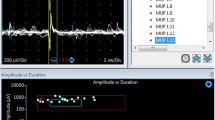Abstract
The role of pelvic neurophysiology in the clinical assessment of patients reporting bladder, bowel, sexual dysfunction and/or pelvic floor complaints is debatable, and this chapter provides an overview of the different tests that are available to assess the pelvic innervation. These include electromyography (EMG), evaluation of sacral reflexes (bulbocavernosus reflex), evoked potential studies (pudendal sensory evoked potentials and motor evoked potentials), nerve conduction studies (measurement of pudendal nerve terminal motor latency) and autonomic testing (recording genital sympathetic skin response). The chapter presents different clinical scenarios where pelvic neurophysiology testing may aid in the diagnosis of patients presenting with unexplained bladder/bowel/sexual complaints.
Access this chapter
Tax calculation will be finalised at checkout
Purchases are for personal use only
Similar content being viewed by others
References
Schwarz J, Kornhuber M, Bischoff C, Straube A. Electromyography of the external anal sphincter in patients with Parkinson’s disease and multiple system atrophy: frequency of abnormal spontaneous activity and polyphasic motor unit potentials. Muscle Nerve. 1997;20:1167–72.
Podnar S, Trsinar B, Vodusek DB. Bladder dysfunction in patients with cauda equina lesions. Neurourol Urodyn. 2006;25:23–31.
Beck RO, Betts CD, Fowler CJ. Genitourinary dysfunction in multiple system atrophy: clinical features and treatment in 62 cases. J Urol. 1994;151:1336–41.
Valldeoriola F, Valls-Sole J, Tolosa ES, Marti MJ. Striated anal sphincter denervation in patients with progressive supranuclear palsy. Mov Disord. 1995;10:550–5.
Vodusek DB. Sphincter EMG and differential diagnosis of multiple system atrophy. Mov Disord. 2001;16:600–7.
Paviour DC, Williams D, Fowler CJ, Quinn NP, Lees AJ. Is sphincter electromyography a helpful investigation in the diagnosis of multiple system atrophy? A retrospective study with pathological diagnosis. Mov Disord. 2005;20:1425–30.
Fowler CJ, Christmas TJ, Chapple CR, Parkhouse HF, Kirby RS, Jacobs HS. Abnormal electromyographic activity of the urethral sphincter, voiding dysfunction, and polycystic ovaries: a new syndrome? BMJ. 1988;297:1436–8.
Wiseman OJ, Swinn MJ, Brady CM, Fowler CJ. Maximum urethral closure pressure and sphincter volume in women with urinary retention. J Urol. 2002;167:1348–51; discussion 1351–2.
Webb RJ, Fawcett PR, Neal DE. Electromyographic abnormalities in the urethral and anal sphincters of women with idiopathic retention of urine. Br J Urol. 1992;70:22–5.
Ramm O, Mueller ER, Brubaker L, Lowenstein L, Kenton K. Complex repetitive discharges—a feature of the urethral continence mechanism or a pathological finding? J Urol. 2012;187:2140–3.
Tawadros C, Burnett K, Derbyshire LF, Tawadros T, Clarke NW, Betts CD. External urethral sphincter electromyography in asymptomatic women and the influence of the menstrual cycle. BJU Int. 2015;116:423–31.
Sihra N, Malde S, Panicker J, Kightley R, Solomon E, Hamid R, et al. Does the appearance of the urethral pressure profile trace correlate with the sphincter EMG findings in women with voiding dysfunction? Neurourol Urodyn. 2018;37:751–7.
Tubaro A, Vodušek D, Amarenco R, Doumouchtsis S, DeLancey J, Fernando R, et al. Imaging, neurophysiological testing and other tests. Paris: ICUD-EAU; 2013.
Cai ZY, Niu XT, Pan J, Ni PQ, Wang X, Shao B. The value of the bulbocavernosus reflex and pudendal nerve somatosensory evoked potentials in distinguishing between multiple system atrophy and Parkinson's disease at an early stage. Acta Neurol Scand. 2017;136:195–203.
Deletis V, Vodusek DB. Intraoperative recording of the bulbocavernosus reflex. Neurosurgery. 1997;40:88–92; discussion 92–3.
Lee DG, Kwak SG, Chang MC. Prediction of the outcome of bladder dysfunction based on electrically induced reflex findings in patients with cauda equina syndrome: a retrospective study. Medicine (Baltimore). 2017;96:e7014.
Pelliccioni G, Piloni V, Sabbatini D, Fioravanti P, Scarpino O. Sex differences in pudendal somatosensory evoked potentials. Tech Coloproctol. 2014;18:565–9.
Opsomer RJ, Guerit JM, Wese FX, Van Cangh PJ. The contribution of electrophysiological tests in the assessment of paraplegia. Acta Urol Belg. 1991;59:61–2.
Cavalcanti GA, Bruschini H, Manzano GM, Nunes KF, Giuliano LM, Nobrega JA, et al. Pudendal somatosensory evoked potentials in normal women. Int Braz J Urol. 2007;33:815–21.
Rodi Z, Vodusek D, Denislic M. Clinical uro-neurophysiological investigation in multiple sclerosis. Eur J Neurol. 1996;3:574–80.
Ormeci B, Avci E, Kaspar C, Terim OE, Erdogru T, Oge AE. A novel electrophysiological method in the diagnosis of pudendal neuropathy: position-related changes in pudendal sensory evoked potentials. Urology. 2017;99:288.e1–7.
Vodusek D, Deletis V, Abbott R, et al. Prevention of iatrogenic micturition disorders through intraoperative monitoring. Neurourol Urodyn. 1990;9:444–5.
Cohen BA, Major MR, Huizenga BA. Pudendal nerve evoked potential monitoring in procedures involving low sacral fixation. Spine. 1991;16:S375–8.
Sala F, Squintani G, Tramontano V, Arcaro C, Faccioli F, Mazza C. Intraoperative neurophysiology in tethered cord surgery: techniques and results. Childs Nerv Syst. 2013;29:1611–24.
Eccher MA. Below the belt: sensory mapping and monitoring in the sacral-pudendal region. J Clin Neurophysiol. 2014;31:323–5.
Vodusek D, Zidar J. Perineal motor evoked responses. Neurourol Urodyn. 1988;7:236–7.
Kiff ES, Swash M. Slowed conduction in the pudendal nerves in idiopathic (neurogenic) faecal incontinence. Br J Surg. 1984;71:614–6.
Opsomer RJ, Boccasena P, Traversa R, Rossini PM. Sympathetic skin responses from the limbs and the genitalia: normative study and contribution to the evaluation of neurourological disorders. Electroencephalogr Clin Neurophysiol. 1996;101:25–31.
Rodic B, Curt A, Dietz V, Schurch B. Bladder neck incompetence in patients with spinal cord injury: significance of sympathetic skin response. J Urol. 2000;163:1223–7.
Secil Y, Ozdedeli K, Altay B, Aydogdu I, Yilmaz C, Ertekin C. Sympathetic skin response recorded from the genital region in normal and diabetic women. Neurophysiol Clin. 2005;35:11–7.
Valles-Antuna C, Fernandez-Gomez J, Escaf S, Fernandez-Gonzalez F. Sympathetic skin response in patients with erectile dysfunction. BJU Int. 2009;104:1709–12.
Acknowledgements
This work was undertaken at the UCLH/UCL Institute of Neurology which received a proportion of funding from the Department of Health’s NIHR Biomedical Research Centres funding scheme.
Author information
Authors and Affiliations
Corresponding author
Editor information
Editors and Affiliations
Rights and permissions
Copyright information
© 2018 Springer International Publishing AG, part of Springer Nature
About this chapter
Cite this chapter
Panicker, J.N. (2018). Pelvic Neurophysiology. In: Dmochowski, R., Heesakkers, J. (eds) Neuro-Urology. Springer, Cham. https://doi.org/10.1007/978-3-319-90997-4_2
Download citation
DOI: https://doi.org/10.1007/978-3-319-90997-4_2
Published:
Publisher Name: Springer, Cham
Print ISBN: 978-3-319-90995-0
Online ISBN: 978-3-319-90997-4
eBook Packages: MedicineMedicine (R0)




